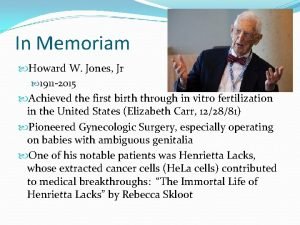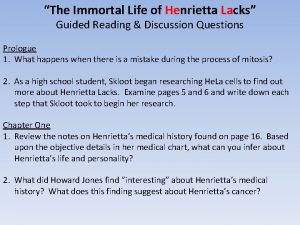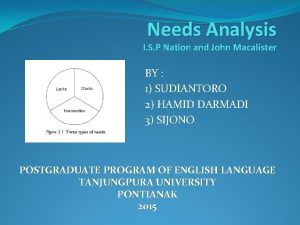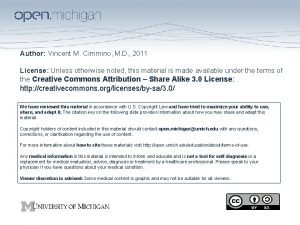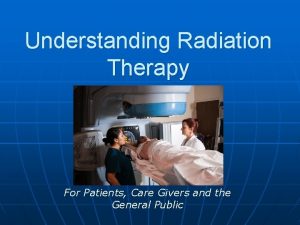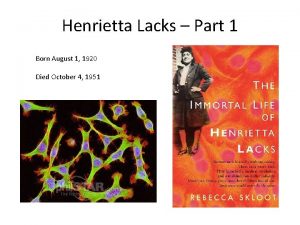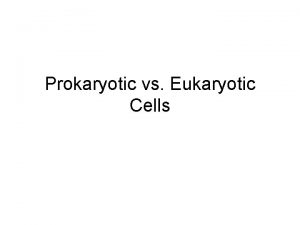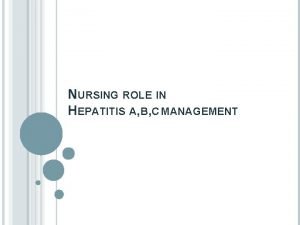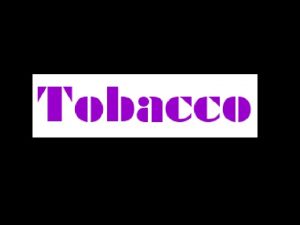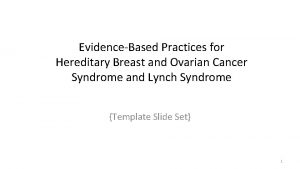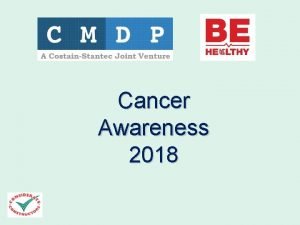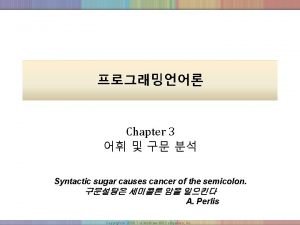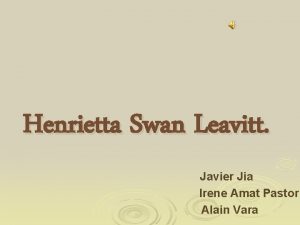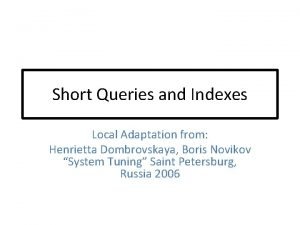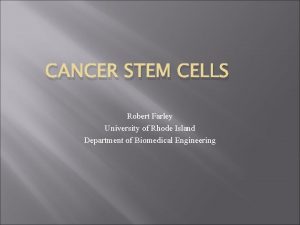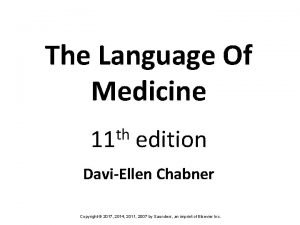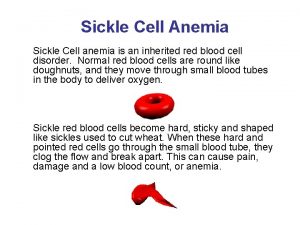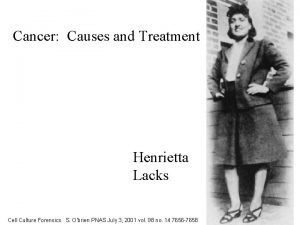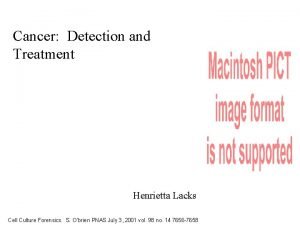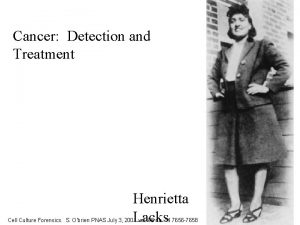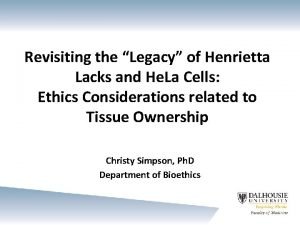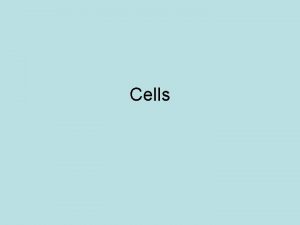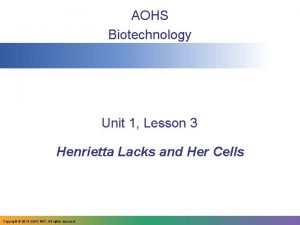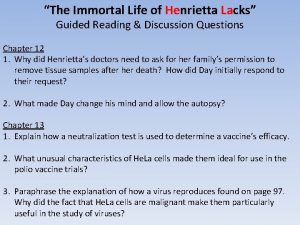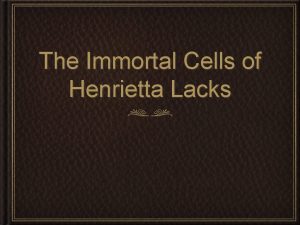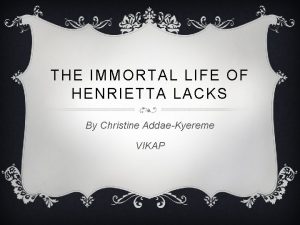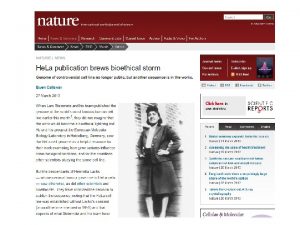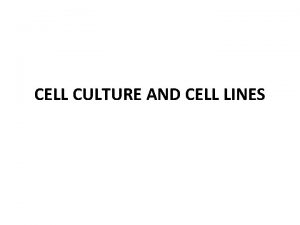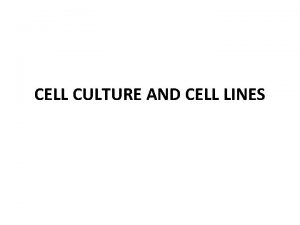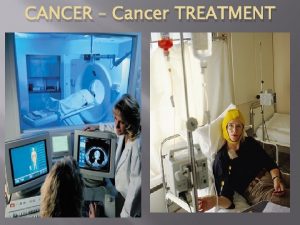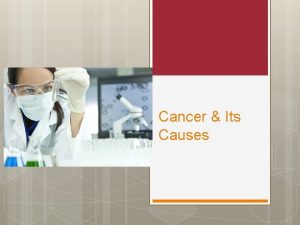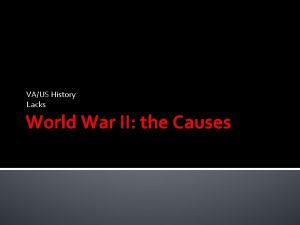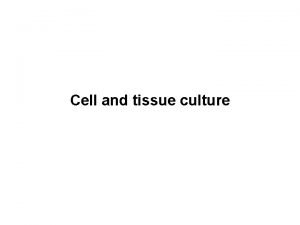Cancer Causes and Treatment Henrietta Lacks Cell Culture



























































- Slides: 59

Cancer: Causes and Treatment Henrietta Lacks Cell Culture Forensics. S. O’brien PNAS July 3, 2001 vol. 98 no. 14 7656 -7658

Henrietta Lacks: the source of He. La cells Cell Culture Forensics. S. O’brien PNAS July 3, 2001 vol. 98 no. 14 7656 -7658

Henrietta Lacks: the source of He. La cells “During the 1970 s and 1980 s, as many as one in three cell lines deposited in cell culture repositories were imposters, one cell line overtaking or masquerading as another. The most notorious culprit was a cervical carcinoma line, He. La, established by George Gey at the Johns Hopkins Medical School in 1951” Cell Culture Forensics. S. O’brien PNAS July 3, 2001 vol. 98 no. 14 7656 -7658

Henrietta Lacks: the source of He. La cells An estimated $10 million of research was discredited. Cell Culture Forensics. S. O’brien PNAS July 3, 2001 vol. 98 no. 14 7656 -7658

Cancer: • is the loss of control over cell division. • Tumors are normal cells that are dividing inappropriately. – They stop performing their “normal” function, and are dividing repeatedly.

A cell becomes cancerous when there are incorrect positive AND negative signals.

Multiple mutations are required for cancer to occur Fig 22. 17

Balance between Longevity and Health Fig. 3 TRENDS in Ecology and Evolution Vol 21 pg 47

How do these mutations arise?

Fig 22. 18 Chromosome abnormalities in cancer cells

Causes of mutations: • Replication errors – Exacerbated by poor DNA repair • Genetic predispositions for poor repair or already having some mutations – Limited by telomere length

Tbl 22. 10

Causes of mutations: • Replication errors – Exacerbated by poor DNA repair – Limited by telomere length • Other biological agents – Viruses – Transposons

Causes of mutations: • Replication errors – Exacerbated by poor DNA repair – Limited by telomere length • Other biological agents – Viruses – Transposons • Environmental factors – Ultraviolet light – Mutagenic chemicals • smoking, industrial waste, natural toxins

Environment plays a large role in the chance of contracting cancer… The multiethnic cohort study: exploring genes, lifestyle and cancer risk. L Kolonel, D Altshuler, B Henderson (July 2004) Nature Reviews Cancer 4, 519 -527 Fig 1

Chernobyl fire April 26, 1986 http: //video. google. com/videoplay? docid=1108163171078608385

The Chernobyl accident was by far the largest unintentional release of radioactive material into the environment and caused widespread contamination in Europe.

After the accident on April 26, 1986, ~116, 000 people were evacuated, most from a zone of 30 -km radius. That included about 45, 000 people from the town of Pripyat.

The most heavily exposed emergency workers received doses that were sufficiently high to kill them in the weeks and months after the accident.

Chernobyl April 26, 1986 Cancer consequences of the Chernobyl accident: 20 years on J. Radiological Protection 26 (2006) 127– 140 Elisabeth Cardis et al.


The rapidity of increased childhood thyroid cancer in the heavily contaminated areas of Belarus, Ukraine and Russia was surprising. 4 years

After the accident on April 26, 1986, ~116, 000 people were evacuated, most from a zone of 30 -km radius. That included about 45, 000 people from the town of Pripyat.


For more pictures: http: //www. nikongear. com/Chernobyl_1. htm

US Mortality, 2000 # of deaths Rank Cause of Death 1. Heart Diseases 2. Cancer 3. Cerebrovascular diseases 4. Chronic lower respiratory diseases 122, 009 5. 1 5. Accidents (Unintentional injuries) 97, 900 4. 1 6. Diabetes mellitus 69, 301 2. 9 7. Influenza and Pneumonia 65, 313 2. 7 8. Alzheimer’s disease 49, 558 2. 1 1. Nephritis 10. Septicemia 710, 760 553, 091 % of all deaths 29. 6 23. 0 167, 661 7. 0 37, 251 1. 5 31, 224 1. 3 Source: US Mortality Public Use Data Tape 2000, National Center for Health Statistics, Centers for Disease Control and Prevention, 2002.

Change in the US Death Rates* by Cause, 1950 & 2000 Rate Per 100, 000 1950 2000 Heart Diseases Cerebrovascular Pneumonia/ Influenza Diseases Cancer * Age-adjusted to the 2000 US standard population. Source: US Mortality Volume 1950, National Vital Statistics Report, 2002, Vol. 50, No. 15.

2003 Estimated US Cancer Cases* Men 675, 300 Women 658, 800 32% Breast Prostate 33% Lung & bronchus 14% Colon & rectum 11% Urinary bladder 6% 6%Uterine corpus Melanoma of skin 4% 4% Non-Hodgkin lymphoma Kidney 3% Oral Cavity 3% Leukemia 3% Pancreas 2% All Other Sites 17% 12% Lung & bronchus 11% Colon & rectum Ovary 3%Melanoma of skin 3%Thyroid 2%Pancreas 2%Urinary bladder 20% All Other Sites *Excludes basal and squamous cell skin cancers and in situ carcinomas except urinary bladder. Source: American Cancer Society, 2003.

2003 Estimated US Cancer Deaths* Lung & bronchus 31% Men 285, 900 Women 270, 600 25% Lung & bronchus Prostate 10% 15% Breast Colon & rectum 10% 11% Colon & rectum Pancreas 5% 6%Pancreas Non-Hodgkin lymphoma 4% 5%Ovary Leukemia 4% 4%Non-Hodgkin lymphoma Esophagus 4% 4%Leukemia Liver/intrahepatic bile duct 3% 3%Uterine corpus Urinary bladder 3% Kidney 3% All other sites 22% 2%Brain/ONS 2%Multiple myeloma 23% All other sites ONS=Other nervous system. *Excludes basal and squamous cell skin cancers and in situ carcinomas except urinary bladder. Source: American Cancer Society, 2003.

Cancer Death Rates*, for Men, US, 19301999 Rate Per 100, 000 Lung Stomach Prostate Colon and rectum Pancreas Leukemia Liver *Age-adjusted to the 2000 US standard population. Source: US Mortality Public Use Data Tapes 1960 -1999, US Mortality Volumes 1930 -1959, National Center for Health Statistics, Centers for Disease Control and Prevention, 2002.

Cancer Death Rates*, for Women, US, 1930 -1999 Rate Per 100, 000 Lung Uterus Breast Colon and rectum Stomach Ovary Pancreas *Age-adjusted to the 2000 US standard population. Source: US Mortality Public Use Data Tapes 1960 -1999, US Mortality Volumes 1930 -1959, National Center for Health Statistics, Centers for Disease Control and Prevention, 2002.

Tobacco Use in the US, 1900 -1999 Male lung cancer death rate Per capita cigarette consumption Female lung cancer death rate *Age-adjusted to 2000 US standard population. Source: Death rates: US Mortality Public Use Tapes, 1960 -1999, US Mortality Volumes, 1930 -1959, National Center for Health Statistics, Centers for Disease Control and Prevention, 2001. Cigarette consumption: Us Department of Agriculture, 1900 -1999.


Tobacco Use in the US, 1900 -1999 Male lung cancer death rate Per capita cigarette consumption Female lung cancer death rate *Age-adjusted to 2000 US standard population. Source: Death rates: US Mortality Public Use Tapes, 1960 -1999, US Mortality Volumes, 1930 -1959, National Center for Health Statistics, Centers for Disease Control and Prevention, 2001. Cigarette consumption: Us Department of Agriculture, 1900 -1999.



Treating cancer: • Avoid it – Avoid mutagens – DNA repair gets less efficient as we age

Our immune system protects us from cancer T-cells recognize and eliminate abnormal cells; such as cells with many mutations

Fig 22. 15 P 53 is activated by DNA damage

p 53 can induce apoptosis via two pathways: Nuclear and/or Mitochondrial

Treating cancer: • Avoid it – Avoid mutagens – DNA repair gets less efficient as we age • Surgery – Must remove all cancer cells – Non-invasive

Treating cancer: • Avoid it – Avoid mutagens – DNA repair gets less efficient as we age • Surgery – Must remove all cancer cells – Non-invasive • Radiation – Directed at tumor; causes DNA damage -> cellular self-destruction – Mutagenic, side effects

Treating cancer: • Avoid it – Avoid mutagens – DNA repair gets less efficient as we age • Surgery – Must remove all cancer cells – Non-invasive • Radiation – Directed at tumor – Mutagenic, side effects • Chemotherapy – Toxins directed at rapidly dividing cells – Mutagenic, many side effects

Chemotherapy xin To X X a rapidly dividing cell

Normal Multi-Drug Resistance protein MDR toxin/hormone/etc MDR

Some cancers over-express MDR MDR MDR toxin MDR I’m a cancer cell with over-expressing MDR. I laugh at your toxins. toxin MDR xin To toxin MDR MDR

Mutations continue after cancer develops The Epigenetic Progenitor Origin of Human Cancer (2007) A P Feinberg, R Ohlsson, S Henikoff Nature Reviews Genetics 7: 21 -31

Evolution: changes in DNA as information transmitted O O O Cancer cell with mutation causing MDR overproduction

Evolution: changes in DNA as information transmitted O O O Apply chemotherapy X X X X X O O O Kills most cells. Except if some have Cancer cell with mutation causing MDR overproduction

Evolution: changes in DNA as information transmitted O O O Apply chemotherapy X X X X X O O O Kills most cells. Except if some have Cancer cell with mutation causing MDR over. Continues to O replicate production

Evolution: changes in DNA as information transmitted O O O Apply chemotherapy Cancer cell with mutation causing MDR over. Continues to O replicate production X X X X X O O O O O O Kills most cells. Except if some have Tumor with cells expressing M

Some cancers over-express MDR MDR MDR toxin MDR I’m a cancer cell with over-expressing MDR. I laugh at your toxins. toxin MDR xin To toxin MDR MDR

Effect of active smoking on the human bronchial epithelium transcriptome (2007) R Chari, K M Lonergan, R T Ng, C Mac. Aulay, W L Lam, and S Lam BMC Genomics, 8: 297

e 1: Subject Demographics ent smoker, FS=former smoker, NS=never smoked Effect of active smoking on the human bronchial epithelium transcriptome (2007) R Chari et el. BMC Genomics, 8: 297

Overlapping and unique genes expression Effect of active smoking on the human bronchial epithelium transcriptome (2007) R Chari et el. BMC Genomics, 8: 297

Some changes in gene expression induced by smoking are reversible CABYR ENTPD 8 Effect of active smoking on the human bronchial epithelium transcriptome (2007) R Chari et el. BMC Genomics, 8: 297 TFF 3 Fig 4 A

Smoking can induce irreversible changes in gene expression MUC 5 AC GSK 3 B Effect of active smoking on the human bronchial epithelium transcriptome (2007) R Chari et el. BMC Genomics, 8: 297 Fig 4 B

Treating cancer: • Avoid it – Avoid mutagens – DNA repair gets less efficient as we age • Surgery – Must remove all cancer cells – Non-invasive • Radiation – Directed at tumor – Mutagenic, side effects • Chemotherapy – Toxins directed at rapidly dividing cells – Mutagenic, many side effects

Cancer: Causes and Treatment Henrietta Lacks Cell Culture Forensics. S. O’brien PNAS July 3, 2001 vol. 98 no. 14 7656 -7658
 The immortal life of henrietta lacks table of contents
The immortal life of henrietta lacks table of contents Howard jones henrietta lacks
Howard jones henrietta lacks The immortal life of henrietta lacks discussion questions
The immortal life of henrietta lacks discussion questions Necessities lacks and wants
Necessities lacks and wants Work on the production line is monotonous and lacks
Work on the production line is monotonous and lacks Treatment of inflammatory breast cancer
Treatment of inflammatory breast cancer Cancer treatment
Cancer treatment Polio
Polio What is propaganda movement?
What is propaganda movement? Jasmine had thought that her irresponsible days of
Jasmine had thought that her irresponsible days of Flagella whip
Flagella whip Hepatitis
Hepatitis Welding causes cancer
Welding causes cancer Welding safety precautions
Welding safety precautions Tobacco causes cancer
Tobacco causes cancer Tobacco causes cancer
Tobacco causes cancer Ovarian cancer causes
Ovarian cancer causes Tobacco causes _______ of cancer deaths around the world. *
Tobacco causes _______ of cancer deaths around the world. * Syntactic sugar causes cancer of the semicolon
Syntactic sugar causes cancer of the semicolon Karolina fryderyka henrietta mercoeur
Karolina fryderyka henrietta mercoeur Henrietta toivanen
Henrietta toivanen Biografia de henrietta leavitt
Biografia de henrietta leavitt Henrietta treffz musicien
Henrietta treffz musicien Henrietta swan leavitt discovery
Henrietta swan leavitt discovery School tool rush henrietta
School tool rush henrietta Henrietta cooke
Henrietta cooke Henrietta dombrovskaya
Henrietta dombrovskaya Henrietta arch pain
Henrietta arch pain Proximate causation biology example
Proximate causation biology example Polygyny in animals
Polygyny in animals Examples of popular culture
Examples of popular culture Fed-batch
Fed-batch Indian vs american culture
Indian vs american culture Stab and stroke culture
Stab and stroke culture Folk culture and popular culture venn diagram
Folk culture and popular culture venn diagram How does popular culture diffuse
How does popular culture diffuse Site:slidetodoc.com
Site:slidetodoc.com Homework due today
Homework due today Stroke culture method
Stroke culture method Describe lawn culture and surface plating
Describe lawn culture and surface plating Surface culture deep culture and esol
Surface culture deep culture and esol Stem cell therapy rhode island
Stem cell therapy rhode island Plasma cell mastitis treatment
Plasma cell mastitis treatment Aplagia
Aplagia Genetic causes of cell injury
Genetic causes of cell injury What causes cell
What causes cell Causes of sickle cell anemia
Causes of sickle cell anemia Individual culture traits combine to form culture patterns.
Individual culture traits combine to form culture patterns. Batch culture vs continuous culture
Batch culture vs continuous culture Individualistic culture definition
Individualistic culture definition Sub culture group
Sub culture group In an inert organizational culture,
In an inert organizational culture, Quality culture changing hearts minds and attitudes
Quality culture changing hearts minds and attitudes Denuding tower
Denuding tower Prokaryotic cell and eukaryotic cell similarities
Prokaryotic cell and eukaryotic cell similarities Venn diagram of plant and animal cell
Venn diagram of plant and animal cell Plant cell structure
Plant cell structure Endoplasmic reticulum function
Endoplasmic reticulum function Primary and secondary cells
Primary and secondary cells Differences between plant animal and bacterial cells
Differences between plant animal and bacterial cells

